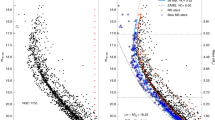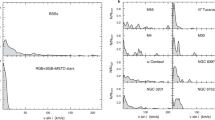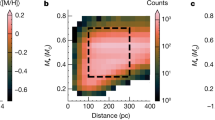Abstract
Globular star clusters that formed at the same cosmic time may have evolved rather differently from the dynamical point of view (because that evolution depends on the internal environment) through a variety of processes that tend progressively to segregate stars more massive than the average towards the cluster centre1. Therefore clusters with the same chronological age may have reached quite different stages of their dynamical history (that is, they may have different ‘dynamical ages’). Blue straggler stars have masses greater2 than those at the turn-off point on the main sequence and therefore must be the result of either a collision3,4 or a mass-transfer event5,6,7. Because they are among the most massive and luminous objects in old clusters, they can be used as test particles with which to probe dynamical evolution. Here we report that globular clusters can be grouped into a few distinct families on the basis of the radial distribution of blue stragglers. This grouping corresponds well to an effective ranking of the dynamical stage reached by stellar systems, thereby permitting a direct measure of the cluster dynamical age purely from observed properties.
This is a preview of subscription content, access via your institution
Access options
Subscribe to this journal
Receive 51 print issues and online access
$199.00 per year
only $3.90 per issue
Buy this article
- Purchase on Springer Link
- Instant access to full article PDF
Prices may be subject to local taxes which are calculated during checkout




Similar content being viewed by others
References
Meylan, G. & Heggie, D. C. Internal dynamics of globular clusters. Annu. Rev. Astron. Astrophys. 8, 1–143 (1997)
Shara, M. M., Saffer, R. A. & Livio, M. The first direct measurement of the mass of a blue straggler in the core of a globular cluster: BSS19 in 47 Tucanae. Astrophys. J. 489, L59–L63 (1997)
Hills, J. G. & Day, C. A. Stellar collisions in globular clusters. Astrophys. J. 17, 87–93 (1976)
Sills, A., Adams, T., Davies, M. B. & Bate, M. R. High-resolution simulations of stellar collisions between equal-mass main-sequence stars in globular clusters. Mon. Not. R. Astron. Soc. 332, 49–54 (2002)
McCrea, W. H. Extended main-sequence of some stellar clusters. Mon. Not. R. Astron. Soc. 128, 147–155 (1964)
Sollima, A., Lanzoni, B., Beccari, G., Ferraro, F. R. & Fusi Pecci, F. The correlation between blue straggler and binary fractions in the core of Galactic globular clusters. Astron. Astrophys. 481, 701–704 (2008)
Knigge, C., Leigh, N. & Sills, A. A binary origin for ‘blue stragglers’ in globular clusters. Nature 457, 288–290 (2009)
Marín-Franch, A. et al. The ACS survey of Galactic globular clusters. VII. Relative ages. Astrophys. J. 694, 1498–1516 (2009)
Dotter, A., Sarajedini, A. & Yang, S.-C. Globular clusters in the outer Galactic halo: AM-1 and Palomar 14. Astron. J. 136, 1407–1414 (2008)
Ferraro, F. R. et al. Blue stragglers in the galactic globular clusters M3: evidence for two populations. Astron. J. 106, 2324–2334 (1993)
Ferraro, F. R. et al. the pure noncollisional blue straggler population in the giant stellar system ω Centauri. Astrophys. J. 638, 433–439 (2006)
Mapelli, M. et al. The contribution of primordial binaries to the blue straggler population in 47 Tucanae. Astrophys. J. 605, L29–L32 (2004)
Mapelli, M. et al. The radial distribution of blue straggler stars and the nature of their progenitors. Mon. Not. R. Astron. Soc. 373, 361–368 (2006)
Davies, M. B., Piotto, G. & de Angeli, F. Blue straggler production in globular clusters. Mon. Not. R. Astron. Soc. 349, 129–134 (2004)
Geller, A. M. & Mathieu, R. D. A mass transfer origin for blue stragglers in NGC188 as revealed by half-solar-mass companions. Nature 478, 356–359 (2011)
Binney, J. & Tremaine, S. Galactic Dynamics (Princeton Univ. Press, 1987)
Lanzoni, B. et al. The blue straggler population of the globular cluster M5. Astrophys. J. 663, 267–276 (2007)
Mapelli, M. et al. Blue straggler stars in dwarf spheroidal galaxies. II. Sculptor and Fornax. Mon. Not. R. Astron. Soc. 396, 1771–1782 (2009)
Monelli, M. et al. The ACS LCID Project. VII. The blue stragglers population in the isolated dSph galaxies Cetus and Tucana. Astrophys. J. 744, 157–170 (2012)
Ferraro, F. R. et al. Two distinct sequences of blue straggler stars in the globular cluster. Nature 462, 1028–1031 (2009)
Trager, S. C., Djorgovski, S. & King, I. R. in Structure and Dynamics of Globular Clusters (eds Djorgovski, S. G. & Meylan, G. ) (Astronomical Society of the Pacific Conference Series Vol. 50) 347–355 (Astronomical Society of the Pacific, 1993)
Heggie, D. C. & Giersz, M. Monte Carlo simulations of star clusters. V. The globular cluster M4. Mon. Not. R. Astron. Soc. 389, 1858–1870 (2008)
Ferraro, F. R. et al. The puzzling dynamical status of the core of the globular cluster NGC 6752. Astrophys. J. 595, 179–186 (2003)
Lanzoni, B. et al. The surface density profile of NGC 6388: a good candidate for harboring an intermediate-mass black hole. Astrophys. J. 668, L139–L142 (2007)
Renzini, A. & Buzzoni, A. in Spectral Evolution of Galaxies (eds Chiosi, C. & Renzini, A. ) 195–231 (Reidel, 1986)
Bekki, K. & Freeman, K. C. Formation of ω Centauri from an ancient nucleated dwarf galaxy in the young Galactic disc. Mon. Not. R. Astron. Soc. 346, L11–L15 (2003)
Djorgovski, S. in Structure and Dynamics of Globular Clusters (eds Djorgovski, S. G. & Meylan, G. ) (Astronomical Society of the Pacific Conference Series Vol. 50) 373–382 (Astronomical Society of the Pacific, 1993)
King, I. R. The structure of star clusters. III. Some simple dynamical models. Astron. J. 71, 64–75 (1966)
Ferraro, F. R. et al. The giant, horizontal, and asymptotic branches of Galactic globular clusters. I. The catalog, photometric observables, and features. Astron. J. 118, 1738–1758 (1999)
Acknowledgements
The authors dedicate this paper to the memory of co-author Bob Rood, a pioneer in the theory of the evolution of low mass stars and a friend who shared our enthusiasm for the BSS topic, who passed away on 2 November 2011. This research is part of the project COSMIC-LAB funded by the European Research Council (under contract ERC-2010-AdG-267675). G.B. acknowledges the European Community’s Seventh Framework Programme under grant agreement no. 229517. F.R.F. acknowledges support from the ESO Visiting Scientist Programme. This research is based on data acquired with the NASA/ESA HST, under programmes GO-11975, GO-10524, GO-8709, GO-6607 and GO-5903 at the Space Telescope Science Institute, which is operated by AURA, Inc., under NASA contract NAS5-26555. The research is also based on data collected at the ESO telescopes under programmes 62.L-0354, 64.L-0439, 59.A-002(A), 69.D-0582(A), 079.D-0220(A) and 079.D-0782(A), and made use of the ESO/ST-ECF Science Archive facility, which is a joint collaboration of the European Southern Observatory and the Space Telescope – European Coordinating Facility.
Author information
Authors and Affiliations
Contributions
F.R.F. designed the study and coordinated the activity. E.D., G.B., R.C., B.L., N.S. and A.M. analysed the data. M.P. and P.M. developed N-body simulations. F.R.F. and B.L. wrote the paper. E.V., A.S., S.S., M.M. and R.T.R. critically contributed to discussion and presentation of paper. All authors contributed to discussion of the results and commented on the manuscript.
Corresponding author
Ethics declarations
Competing interests
The authors declare no competing financial interests.
Supplementary information
Supplementary Information
This file contains Supplementary Text, Supplementary Figures 1-2, Supplementary Table 1 and Supplementary References. (PDF 415 kb)
Rights and permissions
About this article
Cite this article
Ferraro, F., Lanzoni, B., Dalessandro, E. et al. Dynamical age differences among coeval star clusters as revealed by blue stragglers. Nature 492, 393–395 (2012). https://doi.org/10.1038/nature11686
Received:
Accepted:
Published:
Issue Date:
DOI: https://doi.org/10.1038/nature11686
This article is cited by
-
Fast rotating blue stragglers prefer loose clusters
Nature Communications (2023)
-
A clustering study of the old open cluster Trumpler 19
Astrophysics and Space Science (2023)
-
Slowly cooling white dwarfs in M13 from stable hydrogen burning
Nature Astronomy (2021)
-
Study of dynamical status of the globular cluster NGC 1851 using ultraviolet imaging telescope
Journal of Astrophysics and Astronomy (2021)
-
A new class of fossil fragments from the hierarchical assembly of the Galactic bulge
Nature Astronomy (2020)
Comments
By submitting a comment you agree to abide by our Terms and Community Guidelines. If you find something abusive or that does not comply with our terms or guidelines please flag it as inappropriate.



